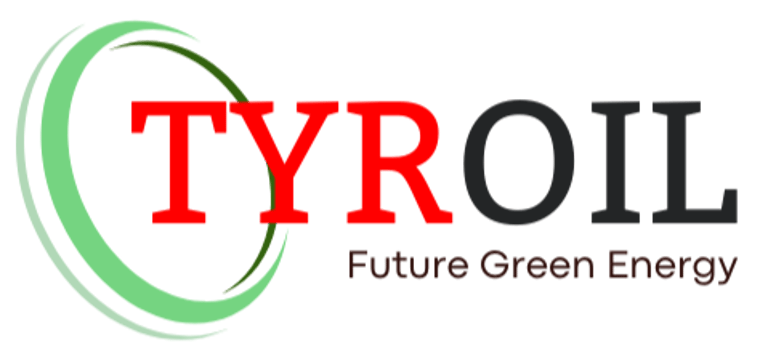The Climate Crisis and Circular Solutions: How TPO and rCB are Redefining Waste Management
THE STORIES
TYROIL
7/9/20255 min read


Our planet is sending us urgent signals. From scorching heatwaves to devastating floods, the impacts of the climate crisis are undeniable, and at its heart lies an unsustainable relationship with resources. We live in a linear economy: we take, we make, we dispose. This model has led to mountains of waste, overflowing landfills, and a relentless release of greenhouse gases into our atmosphere. Among the most stubborn and visible symbols of this linear approach are end-of-life tires. Piled high in dumps, they are not just an eyesore; they are a ticking environmental time bomb, posing fire hazards and leaching harmful chemicals into our soil and water. But what if these symbols of waste could become beacons of hope? What if the very problem could be transformed into a powerful solution for a sustainable future? This is the transformative promise of Tire Pyrolysis Oil (TPO) and Recovered Carbon Black (rCB), two unsung heroes in the fight against climate change and the champions of a new, circular way of thinking.
The Waste Mountain: A Global Burden
Every year, billions of tires reach the end of their useful life. Their sheer volume is staggering, and their resistance to natural degradation means they persist in the environment for centuries. Traditional disposal methods, primarily landfilling, consume vast amounts of land and create significant environmental risks. Tire fires, notoriously difficult to extinguish, release toxic pollutants into the air, soil, and water, posing severe health threats to nearby communities. The decomposition of organic matter within landfills also contributes to methane emissions, a greenhouse gas far more potent than carbon dioxide in the short term [1]. This global waste tire crisis is a stark reminder of our linear consumption patterns and the urgent need for innovative solutions.
TPO: Turning Waste into a Climate Ally
Imagine a bustling city, its skyline often obscured by smog, its outskirts dotted with sprawling, odorous landfills. For years, the city of Harmonia struggled with its waste, particularly the ever-growing piles of discarded tires. Residents complained of respiratory issues, and the local government was at a loss. Then, a new initiative was launched: a state-of-the-art TPO plant. This facility didn't just dispose of tires; it transformed them.
TPO is produced through a process called pyrolysis, where waste tires are heated in an oxygen-free environment. This thermal decomposition breaks down the rubber into valuable components: liquid oil (TPO), solid char (which can be further processed into rCB), and non-condensable gases (syngas). The climate benefits of this process are multi-faceted:
Landfill Diversion & Methane Reduction: By diverting tires from landfills, TPO production directly prevents the land consumption and potential methane emissions associated with their decomposition. This is a crucial step in mitigating climate change [2].
Lower-Carbon Fuel Alternative: TPO can be used as an alternative fuel in industrial applications, such as cement kilns, power plants, and industrial boilers. While it still produces emissions, its production from waste, rather than virgin fossil fuels, offers a significant reduction in overall carbon footprint, especially when considering the avoided emissions from traditional tire disposal [3].
Energy Recovery: The syngas produced during pyrolysis can be used to power the pyrolysis plant itself, making the process energy self-sufficient and further reducing reliance on external energy sources, often fossil fuels.
For the city of Harmonia, the TPO plant became a symbol of progress. The air began to clear, the landfills shrank, and the community breathed a collective sigh of relief. TPO wasn't just a fuel; it was a breath of fresh air.
rCB: The Circular Material Champion
While TPO captures headlines as a fuel, its solid counterpart, Recovered Carbon Black (rCB), is an equally powerful force in the circular economy and climate action. Virgin carbon black (vCB), traditionally produced from fossil fuels, is a key ingredient in tires, plastics, and inks, but its manufacturing process is energy-intensive and generates significant greenhouse gas emissions. rCB offers a sustainable alternative.
Consider a global tire manufacturer, "GreenTread," which had committed to reducing its environmental footprint. For years, they struggled with the carbon-intensive nature of their primary raw material: virgin carbon black. Then, their R&D team discovered rCB, a high-quality material derived from waste tires. By integrating rCB into their new tire lines, GreenTread not only reduced its reliance on fossil fuels but also significantly lowered the embodied carbon in its products.
rCB is produced by processing the solid char residue from tire pyrolysis. Its climate benefits are substantial:
Reduced Virgin Material Demand: rCB directly replaces virgin carbon black, which is typically produced from petroleum feedstocks. This substitution leads to a significant reduction in the demand for fossil fuels and the associated emissions from their extraction and processing [4].
Lower Manufacturing Emissions: The production of rCB generally has a much lower carbon footprint compared to vCB, as it utilizes a waste stream and often requires less energy-intensive processes [5].
Circular Economy Integration: rCB closes the loop on tire materials, transforming a waste product back into a valuable raw material for new products, embodying the principles of a circular economy.
GreenTread's story is a testament to how rCB is not just a substitute but a strategic choice for companies committed to genuine sustainability.
Global Imperative, Local Impact: The Indonesian Context
The climate crisis is a global challenge, but its solutions often manifest at the local level. In Indonesia, a nation grappling with significant waste management issues and vulnerable to the impacts of climate change, TPO and rCB offer particularly relevant solutions. The country generates millions of waste tires annually, and traditional disposal methods exacerbate environmental problems. By embracing TPO and rCB technologies, Indonesia can:
Address Local Waste Challenges: Transform a major waste stream into valuable products, reducing landfill burden and associated pollution.
Contribute to National Climate Targets: Lower greenhouse gas emissions from waste and industrial processes, aligning with Indonesia's commitments under the Paris Agreement.
Foster Green Industries: Create new economic opportunities and green jobs in the waste management and renewable energy sectors.
The adoption of TPO and rCB in Indonesia is not just about environmental compliance; it's about building a more resilient, resource-efficient, and prosperous nation in the face of a changing climate.
Conclusion: Redefining Waste, Reshaping Our Future
The climate crisis demands bold, innovative solutions. Tire Pyrolysis Oil and Recovered Carbon Black stand as powerful examples of how we can redefine our relationship with waste, transforming it from a burden into a valuable asset. By diverting end-of-life tires from landfills, reducing reliance on fossil fuels, and enabling circular material flows, TPO and rCB are not just mitigating environmental damage; they are actively contributing to a more sustainable, climate-resilient future.
These technologies offer a tangible pathway for industries and nations to reduce their carbon footprint, enhance resource efficiency, and build economies that thrive in harmony with the planet. The journey from waste mountain to valuable resource is a testament to human ingenuity and our collective capacity to redefine what's possible. TPO and rCB are not just products; they are symbols of a new era, where sustainability is not an aspiration but a fundamental principle of progress.
More Related Articles:
The Circular City: How Tire Pyrolysis Supports Urban Sustainability
The Circular Story Unfolds: Tire Pyrolysis as a Blueprint for ESG Success
The Ethical Compass: Governance and Transparency in Sustainable Tire Recycling
The Global Footprint: How Tire Pyrolysis is Solving a Worldwide Problem, One Tire at a Time
References
[1] Global trends of waste tire pyrolysis research: a bibliometric analysis. ScienceDirect. [https://www.sciencedirect.com/science/article/pii/S2772783125000135]
[2] A comparative life cycle assessment of tyre recycling using pyrolysis. ScienceDirect. [https://www.sciencedirect.com/science/article/pii/S0921344923003890]
[3] Current Status and Potential of Tire Pyrolysis Oil Production as an Alternative Fuel. MDPI. [https://www.mdpi.com/2071-1050/13/6/3214]
[4] Sustainable Carbon Black Produced from End-of-Life Tire Pyrolysis Oil. Klean Industries. [https://kleanindustries.com/insights/market-analysis-reports/sustainable-carbon-black-from-tire-pyrolysis-oil/]
[5] Production and Upgrading of Recovered Carbon Black from the ... PMC. [https://pmc.ncbi.nlm.nih.gov/articles/PMC8953607/]
